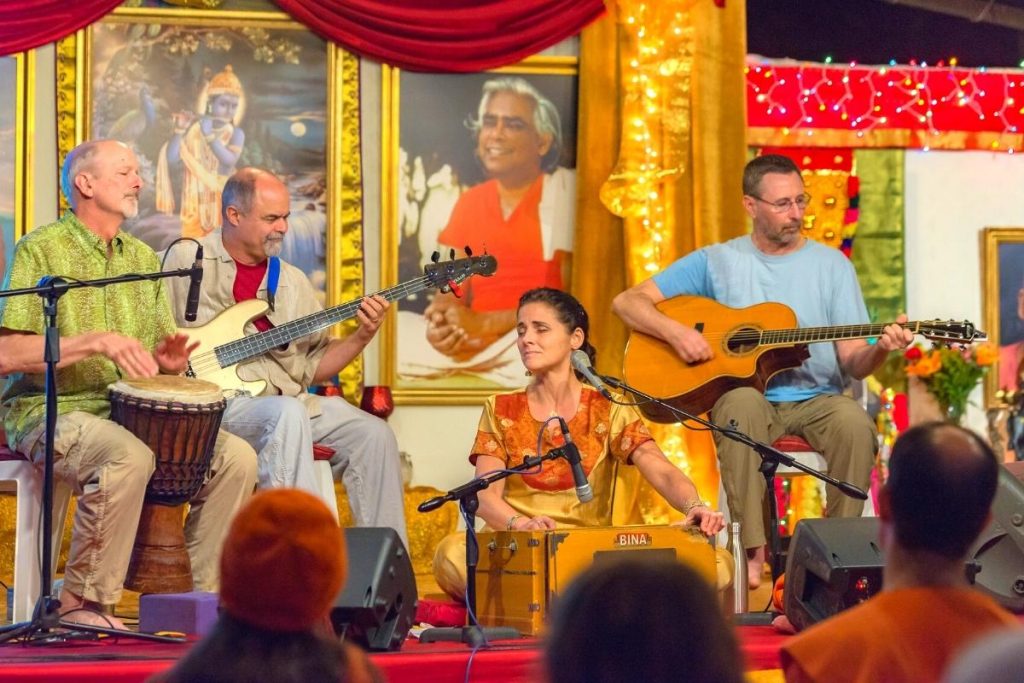Sivananda Bahamas Blog
Expand Your Horizons …
Our Blog
Power of Sound: Heal Yourself with Kirtan
Did you know that you could heal yourself with kirtan? Science is finally catching up with thousands of years of ancient wisdom regarding the chanting of mantras and its many benefits for maintaining peak mental function and overall wellbeing.

Kirtan: The Science Behind the Easy Meditation that Heals the Mind
What is kirtan? Kirtan is derived from the Sanskrit root meaning to call, recite, praise, or glorify. Put simply, it is the act of praising and glorifying some form of divinity. Kirtan involves joyous chanting often performed in a community environment with the accompaniment of instruments such as the harmonium, tabla, and cymbals.
The resurgence of kirtan in the 20th century in the East coincided with a renewed zeal or focus being placed on Bhakti yoga, the yoga of self-surrender and devotion. Swami Sivananda, one of India's modern sages, did much to reignite the fire of kirtan in India by going from town to town and vigorously leading the entire town's population into chants that lasted days. Since the mid-20th century, kirtan and the chanting of mantras has found its way to the West. Many find the chanting of mantras appealing because it doesn't require intense focus and is often done in a collective environment that is supportive and uplifting.
Chanting mantra has been shown to reduce anxiety, depression, dependencies and many mental ailments. The Alzheimer's Research & Prevention Foundation recommends the chant Saa Taa Naa Maa for improving memory, developing greater attention, concentration, and focus, and bettering the mood. Other research studies also showcase the benefit of chanting for chronic pain conditions.
The practice of kirtan or chanting mantra regularly has been shown to bring our bodies back into balance, promoting holistic wellbeing: mental, intellectual, physical, emotional, and spiritual. Chanting helps us regulate our sleep, energy input and output, and, thanks to the stimulation of the vagus nerve, the "rest and digest" response of our bodies which is also responsible for regulating breathing, heart rate, muscles, digestion, circulation, and even the vocal cords. Simply put, chanting helps slow down the heart rate, lower blood pressure, relax different muscles and produce slow, regular, and deep respiration.
Satsang: Why We Chant Mantras Collectively
Kirtan is one of the many foundational practices of Satsang. Satsang is derived from the word sat, meaning truth, and sangha, meaning company. Chanting mantra, whether done through kirtan (joyous chanting), japamala (repetition of mantra using prayer beads), or silent meditation is a practice. A practice has its ups and downs. Maintaining your own mantra practice requires discipline, determination, and concentration. When discipline, determination, and concentration wane, it helps to have a community that will uplift you. The gathering of like-minded individuals at a Satsang helps the brain to associate the pleasure of being social with that of chanting; it helps the body and mind stay regular with the practice; and it provides you with a priceless tool on your spiritual path: that of community. With the support and love of your fellow sadhakas (spiritual aspirants), you are bound to succeed in your spiritual aspirations no matter the obstacles!
At the ashram, we gather for satsang twice daily, always with a shared commitment for pursuing the truth.
Join us virtually for either morning or evening satsang and experience the benefits of guided meditation, kirtan, and spiritual lecture for yourself. We look forward to sharing the magic of mantra with you soon.
On the Transformation of the Self with Mantras: A Personal Account from Karma Yogi Jaya
OMKARI: Describe your experience with kirtan and chanting.
JAYA: I had been practicing hot yoga for a couple of years before I attended a yoga class that included chanting. I found the practice of chanting really weird actually. My conscious mind didn't like it at all, there was a lot of resistance. But there was something about the practice of chanting that made me keep coming back. The more I practiced chanting mantras, the more I could feel the power of the vibrations within my body. I wanted to learn more, I was enamored by the benefits of the the Sanskrit language (also known as the sacred language). I still find it fascinating how much power the Sanskrit language has. Every syllable in Sanskrit connects with a different energy centre (chakra) in our being and when the mantra or syllable is repeated with intention, it penetrates the depths of the unconscious mind.
OMKARI: What are the benefits you have personally experienced as a result of chanting?
JAYA: Chanting the Mahāmrityunjaya Mantra 108 times made me realize how much power the art and practice of mantra-chanting had. When I finish chanting the Mahāmrityunjaya Mantra, I am amazed by the energy gathered from repeating just these four verses. Once I conclude the practice I can feel buzzing through my whole body; I just want to stay in that state of consciousness forever. The first time I completed the chanting of the Mahāmrityunjaya Mantra 108 times, that was also the first time I didn't feel any anxiety.
I took on the practice of chanting this mantra 108 times on day of the full moon in 2018. I haven't missed a single full moon since. The power of this practice assists with health, healing, peace, harmony and freedom from fear. I'll give you an example. During the onset of COVID in February of 2020, I was staying in an ashram in India. One of the karma yogis I washed dishes with was from China, the very place where the news said the outbreak started. She was coughing a bit. Not too long after that I started having cold symptoms. Of course, what I had heard on the news was that this was how it started, with cold symptoms. There were so many people dying at that time from COVID and I was so scared that I was going to give it to the people I was traveling with. I was beside myself. Then, one day, when the anxiety reached its peak and my head felt like it was going to split, the Mahāmrityunjaya Mantra spontaneously started repeating itself in my mind. This helped calm me down and give me something else to focus on.
Fun fact: this mantra is the same length as the Happy Birthday song, 12 seconds to chant, the perfect amount of time for good hand washing.
OMKARI: What are the benefits you have personally experienced as a result of kirtan?
JAYA: Before the outbreak of COVID, I attended kirtans here and there, not too many, and always felt so happy afterwards. Unfortunately, where I live there aren't many kirtans to attend.. maybe 3 or 4 a year. I have a kirtan playlist that I play in the car when I'm driving. However, once COVID hit and since COVID, I haven't been out much at all, I haven't been driving and I haven't been listening to my kirtan playlist. It took me a long time to realize how much of a negative impact the lack of kirtan had on my life.
I don't think I realized how much kirtan could really change things until I attended Rukmini Chaitanya's class back in November [of 2021] on the Narada Bhakti Sutras. I was in a dark place and had lost all motivation. Still, I knew there was something missing. One of the many things Rukmini Chaitanya taught us was to make the practice of kirtan a priority - regardless of your living circumstances. If there were no actual kirtans to attend to, I realized that I could just search kirtan on YouTube, I could start attending the live Satsangs. After Rukmini Chaitanya's course, I searched some YouTube channels and starting playing kirtan in the background throughout the day. I noticed a huge difference in just one day. I felt so much lighter and more positive.
I have not stopped participating in daily kirtan and daily live Satsangs since.
OMKARI: What is your favorite kirtan/mantra/chant? Why?
JAYA: My favourite kirtan is Siva Shambho. It was the first one I ever heard and had only a few words to memorize. Tied for my favorite kirtan is Jaya Siva Sankara. My most fond memory of this kirtan is chanting it as my first kirtan in front of a group in my TTC training in Val Morin with the rest of the TTC students.
OMKARI: Why do you partake in kirtan/chanting?
JAYA: I love to sing. Being in a group that doesn't judge helps because I don't worry about how my voice or the pronunciation of the mantra sounds. The chanting of the mantra, the surrender to complete devotion, makes me feel so good. The practice of mantra chanting is just so energizing.
OMKARI: Some people say that mantra chanting/kirtan is the easiest form of meditation. What are your thoughts on this?
JAYA: Swami Sivananda says Kirtan is the easiest way to God-Realization. I agree; kirtan as a form of meditation doesn't require intense focus, you can really let go and enjoy yourself. The high vibration generated by mantra-chanting is so uplifting. It helps keep your mind focused.
My favourite quote about kirtan by Swami Sivananda explains the benefits of kirtan perfectly:
“Life without Kirtan is like a garden without flowers.” - Swami Sivananda








